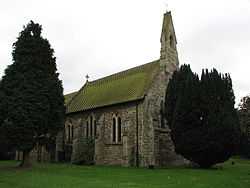Aslockton
| Aslockton | |
 St. Thomas' Church, Aslockton |
|
 Aslockton |
|
| OS grid reference | SK7440 |
|---|---|
| Shire county | Nottinghamshire |
| Region | East Midlands |
| Country | England |
| Sovereign state | United Kingdom |
| Postcode district | NG13 |
| Dialling code | 01949 |
| Police | Nottinghamshire |
| Fire | Nottinghamshire |
| Ambulance | East Midlands |
| EU Parliament | East Midlands |
|
|
Coordinates: 52°57′N 0°54′W / 52.95°N 0.90°W
Aslockton is a village and civil parish twelve miles (19 km) east of Nottingham, England and two miles east of Bingham on the north bank of the River Smite opposite Whatton in the Vale. It has a population of around 1,000 .
Heritage
The name of the village comes from the Danish and Saxon name Haslachstone and became Aslacton before becoming the modern Aslockton.
Thomas Cranmer, Archbishop of Canterbury 1533–1553, was born in Aslockton and lived until the age of 14 in his parents' cottage, which still exists on Abbey Lane. The Archbishop Cranmer Church of England Primary School, opened in 1968, the Cranmer Pre-School and the local social facility, the Thomas Cranmer Centre, are named in his honour. Aslockton originally had its own Holy Trinity Chapel, a peculiar under the collegiate church of Southwell Minster rather than the diocesan bishop,[1] but this became ruined and was incorporated into a private house. Some remains of it can still be seen.[2] Cranmer and his father worshipped at the Church of St. John of Beverley, Whatton.[3] He has also given his name to a local prospect mound.[4]
The land for Aslockton Cemetery was purchased in 1869, at which time the only place of worship in the village was a Methodist chapel, which has since been converted into flats.[5]
The present Grade II listed St Thomas's Church was erected in 1890–92 by the architect Sir Reginald Blomfield,[6] in memory of a former vicar of Whatton, Thomas K. Hall, who drowned in February 1890 as RMS Quetta was wrecked off Queensland on her way to Thursday Island. His mother, Mrs Sophia E. Hall, paid for the church. The Quetta window on the north wall depicting the shipwreck was designed by Michael Stokes in 2002, as was the east window, dedicated to Cranmer, which has Jesus showing his hands to Doubting Thomas.[7] The church as a single bell in a bell cote at the west end.[8] The parish forms part of the Cranmer group, with Hawksworth, Scarrington, Thoroton, Whatton and Orston. The incumbent was Rev. Karl Przywala until the end of 2013, when he was due to take over a parish in Vancouver, British Columbia.[9] The vicarage is in Aslockton.[10]
The village had a population of 363 in 1936.[11]
Amenities
Despite the village's small size, it had two pubs until recently: the Old Greyhound and the Cranmer Arms. The Old Greyhound closed in May 2007, and the new owners have submitted a planning application to turn the building into a restaurant. The village also has a small shop, which includes a post office and a dry-cleaning service. Aslockton Hall contains a nursing and residential home for the elderly.[12]
The Aslockton windmill and bakehouse were situated on Mill Lane (grid reference SK739408).[13] The mill was a wooden postmill, weatherboarded, on a brick roundhouse, with four single patent sails. The miller and baker in 1864 was Job Heathcote.[14]
The village railway station has daily services to Nottingham, Spalding and Skegness A bus service operates to Bingham and Bottesford for onward bus or train connections.
The local community quarterly newsletter, delivered free to every house, is called The Voice.[15]
Sports
Whatton and Aslockton have a joint cricket club said to date back before 1815.[16] It has two senior teams playing in the South Nottinghamshire Cricket League and a colts team playing in the Newark Under 15s Premiership League.[17] Aslockton Cranmer Football Club fields a variety of teams for adults and youngsters.[18] There is also a tennis club,[19] and table tennis teams at the Thomas Cranmer Centre.[20]
Famous residents
- Thomas Cranmer (1489–1556), Archbishop of Canterbury, leader and martyr of the English Reformation, born in Aslockton.
- Chris Urbanowicz, rock musician, was born in Aslockton in 1981.
See also
- Aslockton Castle
- Thomas Cranmer
- St. Thomas' Church, Aslockton
References
- ↑ A Vision of Britain. Retrieved 4 January 2014.
- ↑ Rushcliffe Conservation Area.Retrieved 4 January 2014.; Cranmer Local History Group. Retrieved 4 January 2014. Whatton in 1792.
- ↑ The Nottinghamshire Village Book. Compiled from materials submitted by Women's Institutes in the County (Newbury/Newark: Countryside Books/NFWI), p. 11.
- ↑ Cranmer Local History Group.. Retrieved 4 January 2014.
- ↑ Cranmer Local History Group. Retrieved 4 January 2014. Aslockton Cemetery.
- ↑ Nikolaus Pevsner: The Buildings of England:Nottinghamshire (Harmondsworth, Middx: Penguin, 1979), p. 59.
- ↑ Southwell & Nottingham Church History Project. Retrieved 4 January 2014.
- ↑ A Short Guide to the Parish Churches of the Bingham Rural Deanery, ed. J. Pickworth-Hutchinson. (Bingham: Deanery Chapter, 1963).
- ↑ News report. Retrieved 5 January 2014.
- ↑ Aslockton Online. Retrieved 5 January 2014.
- ↑ Cranmer Local History Group. Retrieved 4 January 2014. The page gives details of the 1936 entry in Kelly's Directory.
- ↑ Care Quality Commission site. Retrieved 5 January 2014.
- ↑ Aslockton and Whatton Local History Group (N.D.), The Changing Village, Nottingham. Page 47.
- ↑ White's Nottinghamshire Directory (1864)
- ↑ Aslockton Online. Retrieved 5 January 2014.
- ↑ Cranmer Local History Digest, September 2005, p. 4. Retrieved 5 January 2014.
- ↑ Aslockton Online. Retrieved 5 January 2014.
- ↑ Aslockton Online. Retrieved 5 January 2014.
- ↑ Aslockton Online. Retrieved 5 January 2014.
- ↑ Aslockton Online. Retrieved 5 January 2014.
External links
| Wikimedia Commons has media related to Aslockton. |
- Aslockton website
- Aslockton in the Domesday Book
- A short, rounded, somewhat critical account of the life of Cranmer. Retrieved 5 January 2014.